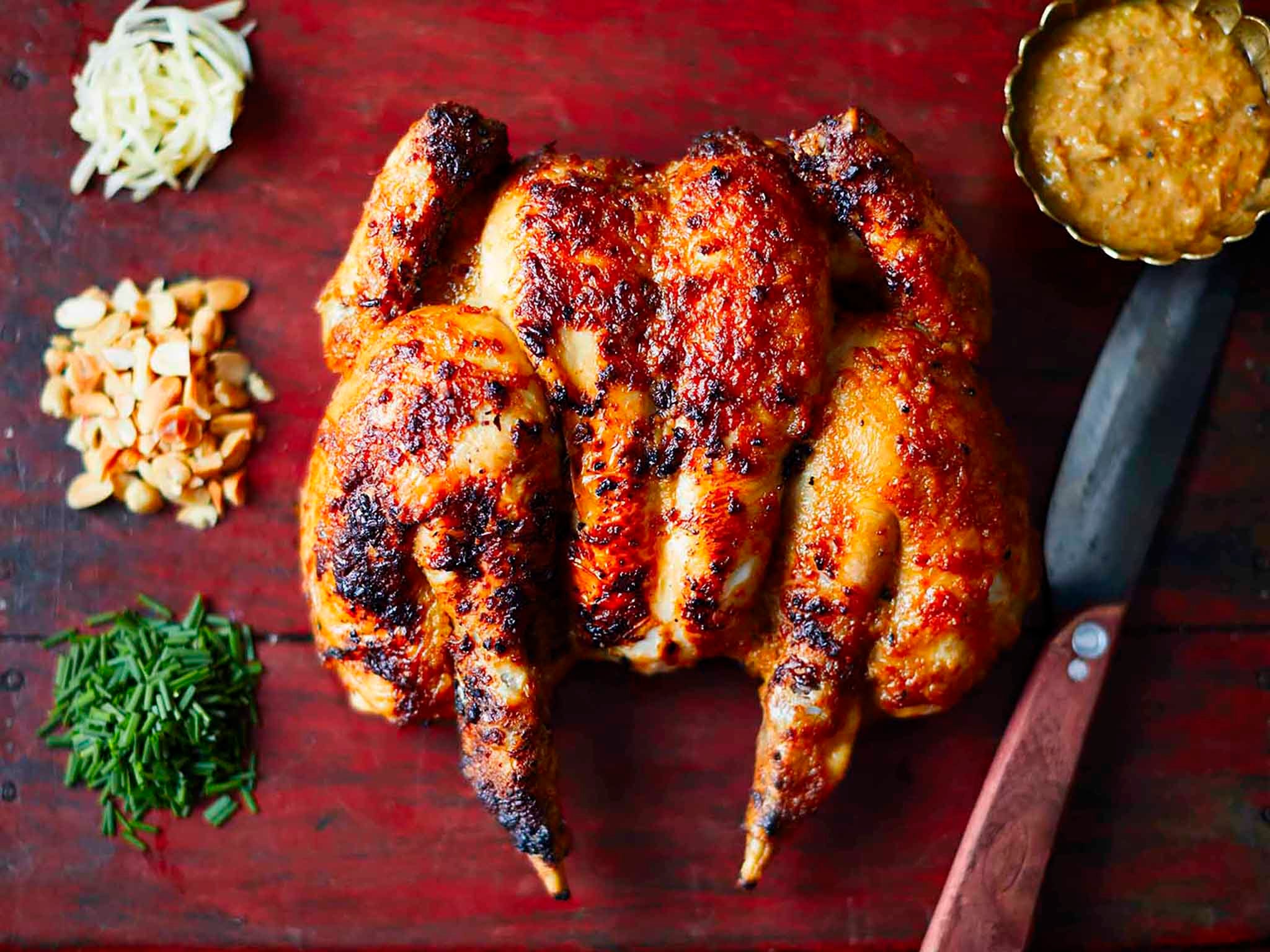Bored of lamb? Cook this satay roast chicken for a perfect Easter feast
Explore a less traditional option this Easter Sunday with my Thai twist on roast chicken, says Sebby Holmes

Your support helps us to tell the story
From reproductive rights to climate change to Big Tech, The Independent is on the ground when the story is developing. Whether it's investigating the financials of Elon Musk's pro-Trump PAC or producing our latest documentary, 'The A Word', which shines a light on the American women fighting for reproductive rights, we know how important it is to parse out the facts from the messaging.
At such a critical moment in US history, we need reporters on the ground. Your donation allows us to keep sending journalists to speak to both sides of the story.
The Independent is trusted by Americans across the entire political spectrum. And unlike many other quality news outlets, we choose not to lock Americans out of our reporting and analysis with paywalls. We believe quality journalism should be available to everyone, paid for by those who can afford it.
Your support makes all the difference.Lamb roasts may be synonymous in the UK with Easter Sunday, but that shouldn’t stop you from exploring less traditional options. Chicken is always a great go-to meat when it comes to a hearty Sunday meal.
Looking for something different to spice up your roast? Try my Thai twist on roast chicken, marinated in sweet, fragrant satay sauce, guaranteed to have you going back for a second plate.
Satay is commonly eaten across Asia and is traditionally used to marinate meats or vegetables before skewering and barbecuing over an open flame. It takes a little dedication to make the curry paste but once you have, marinating and roasting the whole chicken is a breeze.
Satay roasted chicken
Serves: 4
Ingredients:
1 whole large chicken, around 1.5kg, corn fed and free-range
8 large dried red chillies, chopped in half with scissors, soaked in warm water to soften, drained, de-seeded
6 banana shallots, peeled
5 garlic cloves, peeled
1 large knob, roughly 40g, peeled ginger
80g desiccated coconut
80g roasted peanuts
500ml coconut cream
2 tbsp fish sauce
2 tbsp palm sugar
Large pinch coarse salt
6 tbsp coconut oil (vegetable oil can be used instead)
Method:
Firstly, make the paste. In a large pestle and mortar proceed to pound all ingredients one at a time first. Individually pound each ingredient until the mixture begins to resemble a paste, then remove from the pestle and place to one side. Start with the dried chilli, ginger, garlic, shallots, peanuts and then coconut, using salt as an abrasive if needed. Once all ingredients have had a good bashing, continue to add all the ingredients together in the pestle and mortar until they have all become one paste. It is normal for this process to take quite some time to complete properly. Because of the coconut content this paste will only last a week or so, so keep the container it is in wrapped airtight and refrigerated or freeze.
Now cook out the satay curry. In a large non-stick pan add the coconut oil and heat to a high heat. Add the paste and continue to cook out using a metal spoon so you can scrape the paste as it will want to stick to the pan, continue to fry the paste for around 15-20 minutes until the paste darkens slightly and the smell becomes one. I always find when cooking out a curry that you can smell the individual ingredients cooking in turn, until it all blends into one smell once all ingredients are cooked and fused together. At this stage add the palm sugar and turn the paste down to a medium heat, continue to stir and scrape until the sugar caramelises and the paste begins to darken. When this happens add the fish sauce – adding this moisture to the paste will deglaze any paste that has stuck a little to the pan. Next take off the heat and add the coconut cream and mix well.
Allow this mix to cool and then place the chicken in a tray and cover with the cooked-out curry paste, making sure to completely cover the whole chicken under and over with the cooked paste. Then leave this to marinate for a minimum of 2 hours, ideally overnight.
Once marinated, pre-heat an oven to 200C and place the chicken, skin side up, in a non-stick tray, covered with tin foil on the middle shelf for 40-45 minutes, then remove the tin foil and cook for a further 20 minutes to colour the skin. The paste on the top should be beginning to crisp a little and the chicken juices should be running into the curry paste. Check that the chicken is cooked throughout by making an incision at the leg all the way down to the bone and checking if there are any signs of blood. If there is, return to the oven for a further 5-10 minutes until it is cooked, and the juices run clear. For best results use a temperature probe, you can take it out at 75-80C and it will still be moist and succulent. Allow to rest for 5 minutes before serving.
Serve with steamed jasmine rice and carve at the centre of the table.
Recipe taken from ‘Cook Thai’ by Sebby Holmes (published by Kyle Books, photography by Tom Regester, food styling by Becks Wilkinson).
Join our commenting forum
Join thought-provoking conversations, follow other Independent readers and see their replies
Comments